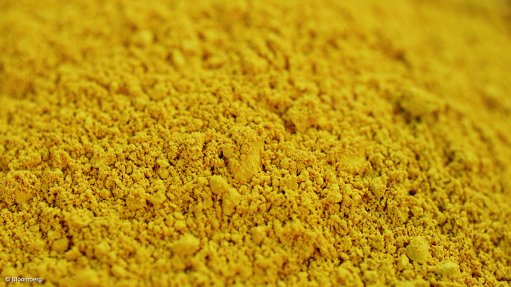
Photo by: Bloomberg
PERTH (miningweekly.com) – Uranium developer Lotus Resources on Thursday announced a merger with fellow listed A-Cap Energy to create an Africa-focused uranium player.
Under a scheme of arrangement, A-Cap shareholders would receive one new Lotus share for every 3.54 shares held, implying a value of 5.2c a share for A-Cap shares. The implied value offered a 10.4% premium to the company’s 30-day volume weighted average share price and a 20.7% premium to the company’s last closing price on July 11.
The A-Cap board has unanimously recommended that shareholders accept the offer, in the absence of a superior proposal and subject to an independent expert concluding that the offer was in the best interest of shareholders.
If the share scheme is approved and implemented, Lotus shareholders will hold approximately 79% of the merged group and A-Cap shareholders will hold approximately 21% of the merged group.
“To A-Cap Energy shareholders, this merger provides immediate value realisation at a premium,” said A-Cap deputy chairperson Paul Ingram.
“It also provides the opportunity to become a shareholder in Lotus, a larger, more liquid vehicle, while retaining meaningful exposure to Letlhakane and significant leverage to the global uranium thematic. Becoming a part of a larger group significantly reduces development, funding and execution risk.”
Lotus is progressing the development of the Kayelekera uranium project, in Malawi.
A recently completed definitive feasibility study (DFS) into the restart of the Kayelekera uranium project found that the project would require a capital investment of $88-million with cash costs estimated at $29.1/lb and an all-in sustaining cost of $36.2/lb during the first seven years of production of a ten-year mine life.
Based on an ore reserve estimate of 15.9-million tonnes, at 660 parts per million uranium oxide (U3O8), for 23-million pounds of U3O8, the DFS estimated that the project would produce an average of 2.4-million pounds U3O8 over the mine life.
For its part, A-Cap owns the Letlhakane uranium project, in Botswana, and the Wilconi cobalt project in Western Australia.
Letlhakane could support the production of 3.75-million pound of uranium a year over a mine life of 18 years, and A-Cap was awarded a mining licence for the area in 2016, which is valid for a period of 22 years.
“Combining the uranium assets of Lotus and A-Cap creates a dedicated African uranium vehicle that meets the needs of the growing uranium market,” said Lotus MD Keith Bowes.
“Lotus’ resource base will increase almost five-fold, from 51.1-million pounds to 241.5-million pounds, while A-Cap shareholders will gain exposure to a production-ready asset in Kayelekera. The shareholders of both groups will share in the benefits of a long-term development project complementing Kayelekera’s shorter-term uranium production profile.”
The combined entity would also have an enhanced market position and increased trading liquidity, while the transaction will offer the potential for future inclusion in relevant ASX- and uranium-specific indices.
The companies said in a statement on Thursday that the combined group would accelerate and de-risk the development of Letlhakane by using anticipated free cash flows from Lotus’ production-ready project, while Lotus would offer operational experience and exploration expertise to expedite project development.
The merger would also reduce the risk and uncertainty regarding potential exploration and development as compared to a single-asset company.
The merger is subject to a number of conditions, including regulatory, court and shareholder approvals.